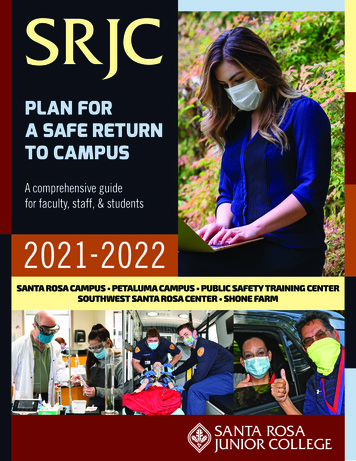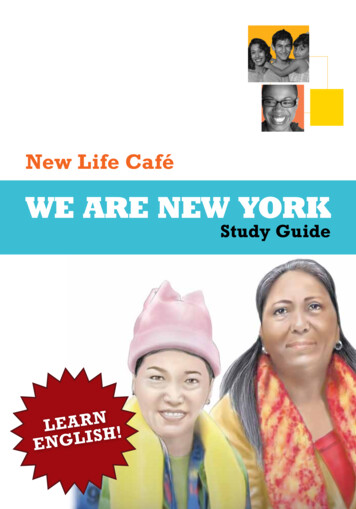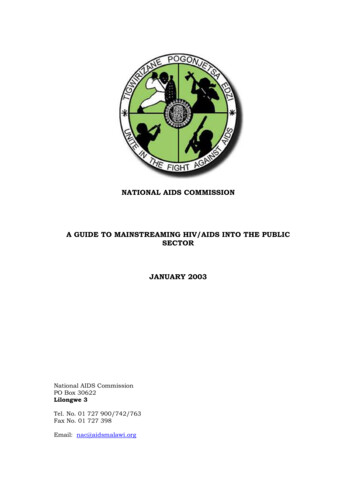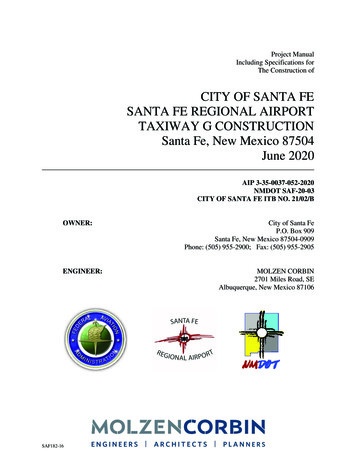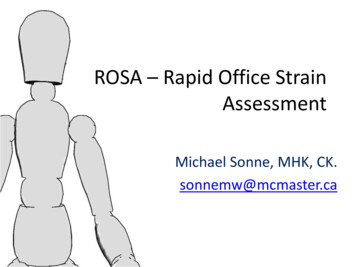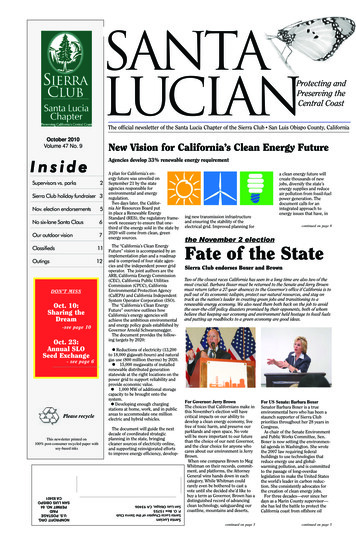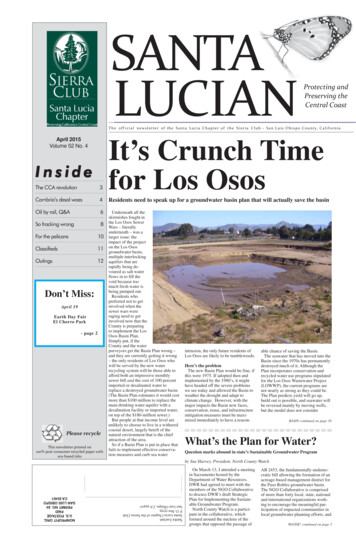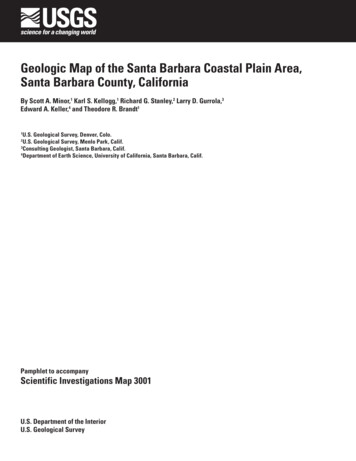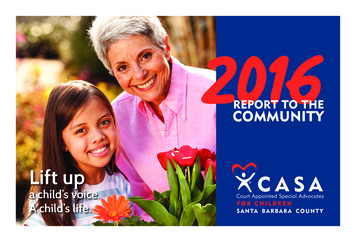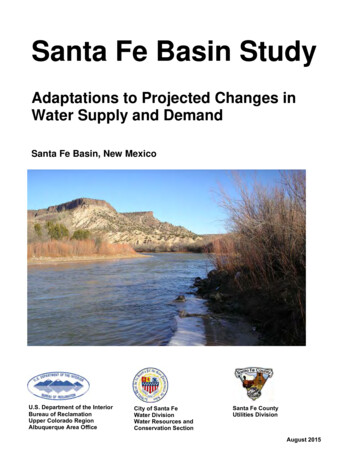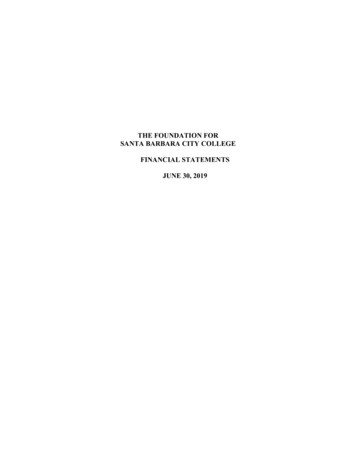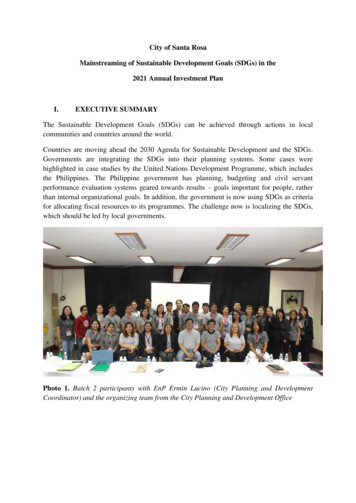
Transcription
City of Santa RosaMainstreaming of Sustainable Development Goals (SDGs) in the2021 Annual Investment PlanI.EXECUTIVE SUMMARYThe Sustainable Development Goals (SDGs) can be achieved through actions in localcommunities and countries around the world.Countries are moving ahead the 2030 Agenda for Sustainable Development and the SDGs.Governments are integrating the SDGs into their planning systems. Some cases werehighlighted in case studies by the United Nations Development Programme, which includesthe Philippines. The Philippine government has planning, budgeting and civil servantperformance evaluation systems geared towards results – goals important for people, ratherthan internal organizational goals. In addition, the government is now using SDGs as criteriafor allocating fiscal resources to its programmes. The challenge now is localizing the SDGs,which should be led by local governments.Photo 1. Batch 2 participants with EnP Ermin Lucino (City Planning and DevelopmentCoordinator) and the organizing team from the City Planning and Development Office
In this regard, the City of Santa Rosa organized an orientation on Mainstreaming SDGs inthe 2021 Annual Investment Plan. The said activity was done in three (3) batches: Batch 1March 2, 2020City Social Welfare &Development OfficeOffice of Senior CitizenAffairsOffice of Persons withDisabilities AffairsCity Health Office 1City Health Office 2Santa Rosa CommunityHospitalCity Nutrition OfficeGender & DevelopmentOfficeCity Tourism OfficeCulture and Arts ProjectsCity Anti-Drug AbuseUnitPeace and Order CouncilCity Disaster RiskReduction andManagement OfficeCity Engineering Office Batch 2March 3, 2020City Agriculture OfficeCity Veterinary OfficeCity Cooperative OfficeCity Environment andNatural Resources OfficeBusiness Permit andLicensing OfficeOffice of the BuildingOfficialLocal EconomicEnterprise ManagementOffice / City MarketOfficeCity Civil Registrar‟sOffice / City CemeteryOfficeCity Treasury OfficeCity Budget OfficeCity Labor andEmployment OfficeGeneral Service OfficeOperation of Santa RosaCity MultipurposeComplex / City SportsOfficePeace and Order SafetyOffice Batch 3March 4, 2020Office of the City Mayor/ City Administrator‟sOfficeOffice of the City ViceMayorSP Legislative Office /Office of the SPSecretaryCity Human ResourcesManagement OfficeCity Information OfficeCity Legal OfficeCity Assessor‟s OfficeCity Accounting OfficeCity InformationTechnology OfficeSanta Rosa CityManpower TrainingCenterCity Traffic Managementand Enforcement UnitCity Civil Security andService OfficeCity Youth DevelopmentOfficePhilHealth OfficeManagement and InternalAudit UnitTable 1. Summary of participating officesOrientation OverviewTo ensure that the local planning is aligned with the SDGs, the Santa Rosa City Planning andDevelopment Office conducted an orientation on Mainstreaming SDGs in the 2021 AnnualInvestment Plan last March 2-4, 2020 at the 2nd Floor AVR Gusaling Museo, City of SantaRosa, Laguna. The said orientation was attended by the representatives from the differentoffices and units of the City Government of Santa Rosa.The one-day orientation facilitated discussion on SDGs, AmBisyon Natin 2040, PhilippineDevelopment Plan, and AIP. The orientation also served as a venue to encourage therevisiting and aligning of plans being prepared for the AIP on the SDGs.
II.HIGHLIGHTS OF THE ACTIVITYA. AmBisyon Natin 2040EnP. Ermin Lucino (City Planning and Development Coordinator) presented the AmBisyonNatin 2020. A Presentation material from NEDA IV-A was used with permission of the saidorganization.AmBisyon Natin 2040 is a long-term (25 years)vision for the Philippines and an anchor fordevelopment planning across administrations.Vision of Filipinos for Self“In 2040, we will all enjoy astable and comfortable lifestyle,secure in the knowledge that wehave enough for our daily needsand unexpected expenses, that wecan plan and prepare for our ownand our children’s future. Our family lives together in a placeof our own, and we have the freedom to go where we desire,protected and enabled by a clean, efficient, and fairgovernment."Vision of Filipinos for the Country“By 2040, the Philippines shall be a prosperous, predominantlymiddle-class society where no one is poor. Our peoples willenjoy long and healthy lives, are smart and innovative, and willlive in a high-trust society”It was highlighted that an overwhelming majority of Filipinos aspire for a simple andcomfortable life.EnP Lucino mentioned that the vision could be achieved through enablers such as economicgrowth, investing in people (e.g. health and education), and protection against instability.Development strategies were discussed, such as enhancing the social fabric (malasakit),reducing inequality in economic development opportunities (pagbabago), and increasingpotential growth (patuloy na pag-unlad).
B. Sustainable Development Goals (SDG)The session started with a brief discussion that looks back on how the global developmentindicators came about. From being concerned solely on 1960 to 1970, it is evolving to apeople-centered view that looks deeper on equity and then now a holistic approach onsustainable development.1960-1970economicgrowth1970-1990basic needsandredistributionwith growth;growth withequity1990-2000humandevelopmentand sustainabledevelopmentFigure 1. Global development indicators timeline2000-20158 MillenniumDevelopmentGoals (MDG)2015-203017 SustainableDevelopmentGoals (SDG)
Photo 2. Batch 1 participants while listening to the discussion on SDGsTable 2 summarizes the themes, frameworks, and supporting schools of thought on the globaldevelopment indicators from 1960 to 2030.PeriodThemes & FrameworksSupporting Schools of Thought1960 to1970“Growth at all Costs;”– “Grow first, clean uplater.”Modernization TheoryGrowth Pole & Trickle DownNeo-Classical Economics1970 to1980“Growth with Equity” and variants– “Growth withRedistribution– “Growth withParticipation”– “SocialTransformation”– “Integrated AreaDevelopment”Neo-Marxist Dependency TheoriesWorld Systems TheoryNeo-PopulismTheories of Alternative Development &Another Development1980 to1990“New International Economic Order”– “StructuralAdjustment”Neo-Liberal EconomicsReagonomics & ThatcherismTheories of Globalization
1990 to2000“Sustainable Development”Ecology SchoolsEnvironmental Ethics2000 to2015“Millennium Development Goals”Theories of Human Capital and Social Capital2015 to2030“Sustainable Development Goals”Sustainable Development MDGsTable 2. United Nations’ Decades of DevelopmentOne way to measure progress is by looking intothe 5Ps that shape sustainable development,namely: people, planet, prosperity, peace, andpartnerships. Unlike the previous globalmeasures of development, the SDGs are anintertwined framework instead of a group ofsiloed goals.It was explained that progress on one elementmust balance and support progress on another.Figure 2 shows the interconnectedness amongthese five elements that make up sustainabledevelopment.Figure 2. Sustainable Development conceptSource: -getting-startedguide-FINAL-PDF-.pdfA Glance at the Sustainable Development Goals (SDGs)The SDGs are an ambitious set of 17 goals and 169 targets that were defined and developedthrough an unprecedented dialogue among UN Member States, local authorities, civil society,the private sector, and other stakeholders.
Figure 3. The Sustainable Development GoalsWith the participants being heads and representatives of different offices from the CityGovernment of Santa Rosa, the discussionfocused on SDG 11. Make cities andhuman settlements inclusive, safe, resilientand sustainable.EnP Lucino asked the participants why theythink the focus is in cities. He mentioned thatat present, more than half the world‟spopulation lives in cities. And by 2030, it isprojected that six (6) of ten (10) people willbe urban dwellers. He also mentioned that despite numerous planning challenges, cities offermore efficient economies of scale on many levels, including the provision of goods, servicesand transportation. With sound, risk-informed planning and management, cities can becomeincubators for innovation and growth and drivers of sustainable development.SDG 11, on sustainable cities and communities, is the lynchpin of the localizing process. Itsinclusion in the 2030 Agenda is the fruition of the advocacy work of the broad urbancommunity (particularly local and regional government associations). Linking SDG 11 upwith the urban dimensions of the other 16 goals will be an essential part of the localization ofthe SDGs.
To provide a clear view on what it means to be a sustainable city and community, its ten (10)indicators were presented, namely:Target 11.1Target 11.2Target 11.3Target 11.4Target 11.5Target 11.6Target 11.7Target 11.ATarget 11.BTarget 11.CSafe and affordable housingAffordable and sustainable transport systemsInclusive and sustainable urbanizationProtect the world‟s cultural and natural heritageReduce the adverse effects of natural disastersReduce the environmental impacts of citiesProvide access to safe and inclusive green and public spacesStrong national and regional development planningImplement policies for inclusion, resource efficiency, and disasterrisk reductionSupport least developed countries in sustainable and resilientbuildingThe Philippines, being one of the signatories in pursuing the SDGs, is committed to achievingits goals. With this, local governments play a critical role with the challenge on how tolocalize the global indicators.The City of Santa Rosa was the first city to do the Climate Change Expenditure Tagging(CCET). EnP Lucino encouraged the participants to dig deeper on the SDGs in theirrespective plans.C. Annual Investment ProgramFor this session, ten (10) questions were given about the AIP and its process. Participantswere to answer individually on their booklets, and were given two (2) minutes per question.The participants will be able to check their answers by the end of the session. (See Annex)This was followed by a review of some planning and budget nomenclatures or terms, such as: Comprehensive Land Use Plan (CLUP)– long term plan of the city (10-15 years)– deals on how to use the land of the city towards a certain goal– zoning ordinance– geographical, territorial sense,Comprehensive Development Plan (CDP)– short to medium term plan of the city (3-5 years)– multi-sectoral (economic, social, infrastructures, environmental and naturalresources, and institutional programs)– embodies the vision, sectoral goals, objectives, development strategies andpolicies of the LGU– serve as primary inputs to investment programming and subsequent budgetingand implementation of projects for the growth and developmentLocal Development Investment Program (LDIP)– one major output of the CDP
– a three to six years infrastructure plan of the city government approved by theCity Development Council (CDC)– is a basic document linking the local plan to the budget Executive-Legislative Agenda (ELA)– contains the priorities of the mayor and the sanggunian– short to medium term plan of the city (3 years)– correspond to the term of local elective officials Annual Investment Program (AIP)– a one-year development plan based on the LDIP approved by CDC– annual slice of the LDIP– constitutes the total resource requirements for all PPAs– reinforces plan-budget linkage Profile– Annual updating of planning and budgeting database– Socioeconomic, physical resources, time series revenue and expenditure data,project profiles/status, etc.– Analysis of planning environment for plan preparation / review / updating(situational analysis, assessment of implementation) Annual Budget– Local budgets shall operationalize approved local development plans. (Section305 [i], RA 7160)– Local governments shall formulate sound financial plans, and the localbudgets shall be based on functions, projects and activities in terms ofexpected results. (Section 305 [g], RA 7160)– Parts of the Executive Budgeto 2 parts Estimate of Income Proposed Expenditure Annual Procurement Plan (APP)– The requisite document that the agency must prepare to reflect the necessaryinformation on the entire procurement activities (ex. goods, services, civilworks to be procured) that it plans to undertake within the calendar year Project Procurement Management Plan (PPMP)– Monthly slice / allotment of the Annual Procurement Plan Supplemental Investment Plan (SIP)– constitutes the resource requirements for all PPAs that is not included in theAIP– Savings– Support from National Government Supplemental Budget– A Budget that is enacted after the Annual Budget. Pursuant to Section 321-322of the Local Government Code– Can only appropriated with an approved Supplemental Investment Plan
Photo 2. EnP Ermin Lucino (CPDC) providing a brief discussion on some planning andbudgeting termsTo give a clear picture of the process, EnP Lucino presented the PPAs structure review:Analyze results ofexisting PPAsrelevancePolicy ObjectivesconsistenceIf YESStatus Quo /Continue with thePPAsIf NODetermine CausesRedesign / Scrap /Introduce newPPAsFigure 4. PPAs Structure Review ProcessThe relevance and consistence of the PPAs and its results must be analysed and its alignmentto the policy objectives reviewed. This will determine whether or not the PPAs should becontinued, redesigned, or scrapped, or if there is a need to introduce new interventions.Table 3 shows the indicative schedule of the AIP to Budget preparation.
PeriodActivityIn-charge1st WeekJanuaryCDC thru the CPDC sets guidelines fordata gatheringCPDCJan - MayUpdating of Planning and BudgetingDatabaseLFC, Department Heads,NGAs, etc.April - MayAnalysis for plan preparation. Review,updatingCFO, Department Heads,NGAs, etc.June 1 – 15Preparation of the AIP Summary Form –submit to LCE for CDC ConcurrenceCPDC, LBO, LFC, LCEJune 5Issue Budget CallLCEJuly 5Conduct Budget ForumLCE / LFC / Dept. HeadsJuly 15Prepare and Submit Budget ProposalsDepartment HeadsNot later than1st Week ofAugustApproval of the AIPSPJuly 16 –August 14Review and Consolidate Budget ProposalsLBOAugust 15Conduct Budget HearingLCE / LFCSeptember 30Prepare the LEPLCE / LFCOctober 10Prepare Budget Message and Budget ofExpenditures and Sources of Financing(BESF)October 16Submit Executive Budget to theSanggunianTable 3. AIP to Budget Preparation ScheduleLCE
D. Relevance of SDGs in Local PlanningThe 17 SDGs and 169 targets of the 2030 Agenda must be achieved at global, national andsubnational levels. „Localizing‟ is the process of taking into account subnational contexts inthe achievement of the 2030 Agenda, from the setting of goals and targets, to determining themeans of implementation and using indicators to measure and monitor progress.Localization relates both to how the SDGs can provide a framework for local developmentpolicy and to how local and regional governments can support the achievement of the SDGsthrough action from the bottom up and to how the SDGs can provide a framework for localdevelopment policy.While the SDGs are global, their achievement will depend on our ability to make them areality in our cities and regions. All of the SDGs have targets directly related to theresponsibilities of local and regional governments, particularly to their role in deliveringbasic services. Many of the investments to achieve the sustainable development goals willtake place at the subnational level and be led by local authorities. That‟s why local andregional governments must be at the heart of the 2030 Agenda.The achievement of the SDGs depends, more than ever, on the ability of local and regionalgovernments to promote integrated, inclusive and sustainable territorial development.National legal and political frameworks still have a long way to go in recognizing this, andnational and international advocacy work on behalf of local and regional governmentsremains necessary.Mainstreaming SDGs in the 2021 AIPPerformance indicators should be should be aligned with Ambisyon Natin and SDGs. EnP.Lucino shared three (3) points in mainstreaming SDGs in the 2021 AIP: Align the AIP expected outcome with the SDG indicator (local context)Specify the SDG target/s and indicator/sAt least include one aligned SDG indicator per department / officeOPEN FORUMThe floor was opened for questions, clarifications, and concerns related to the mattersdiscussed.One of the participants asked how the procurement process can be improved. Someparticipants also shared that there are cases of lost documents submitted by departments (e.g.original attendance sheet) when suppliers claim payment. It was agreed that the City Planningand Development Office and the Budget Office shall write a letter to General Services Office(GSO) to check the reason for some delays and include suggestion. It was also recommendedby the group for the procurement process to be reviewed.
PreparedANJELA MAE ERAPopulation Program Officer IReviewedEnP. GINA B. MADINPlanning Officer IVApprovedEnP. ERMIN V. LUCINO, MPM, AICP, PMPCity Planning and Development Coordinator
ANNEXQuestions for the Activity on AIP Process Review1. All of the following statements about AIP are correct except:a. a one-year development plan based on the LDIP approved by CDCb. basis of the Supplemental Investment Planc. annual slice of the LDIPd. constitutes the total resource requirements for all PPAse. consists of the annual expenditure and regular operating requirements of the cityf. None of the Aboveg. All of the Above2. It is defined as the expenditures to support the operations of government agencies such asexpenses for supplies and materials; transportation and travel; utilities (water, power, etc.) andthe repairs, etc.a. Personnel Services (PS)b. Maintenance, Operations and Operating Expenses (MOOE)c. Capital Outlay (CO)d. Forward Estimates (FE)e. None of the Abovef. All of the Above3. Approval of the 2021 AIP by the Local Sanggunian should be:a. Not later than December 31, 2020b. Not later than October 1, 2020c. Not later than first week of August 2020d. Not later than last week of June 2020e. None of the Above4. All of the following statements about Supplemental Investment Plan(SIP) are correct except:a. Basis of the Supplemental Budgetb. Consists of the annual expenditure and regular operating requirements of the cityc. Constitutes the resource requirements for all PPAs that is not included in the AIPd. Funded through savings and grantse. None of the Abovef. All of the Above5. A special undertaking to be carried out within a definite timeframe which is intended to resultin some pre-determined measure of goods and services is a:a. Policyb. Programc. Projectd. Activitye. None of the Above
6. A work process designed to contribute to the accomplishment of specific objectives and theimplementation of a program, sub-program, or project:a. Policyb. Programc. Projectd. Activitye. None of the Above7. The Project Procurement Management Plan (PPMP) should be submitted to which office?a. CPDOb. Budget Office and GSOc. SPd. COAe. Accountingf. None of the Aboveg. All of the Above8. Units of measures that best represent the effectiveness and efficiency of a department / officein the delivery of its Major Final Outputs.a. Policyb. Performance Indicatorsc. Organizational Outcomed. Visione. None of the Abovef. All of the Above9. Performance indicators should have the SMART Attributes, the following statements are trueabout the SMART attributes except for: Performance Indicatorsa. Specific (results that are trying to achieve)b. Measurable (stated in quantifiable terms)c. Achievable (Realistic or capable of being achieved)d. Relevant (logically related to MFO)e. Time-Bound (with specific target dates)f. None of the Aboveg. All of the Above10. The requisite document that the agency must prepare to reflect the necessary information onthe entire procurement activities (ex. goods, services, civil works to be procured) that it plansto undertake within the calendar yeara. AIPb. PPMPc. APPd. SIPe. Budgetf. None of the Aboveg. All of the Above
Table 2 summarizes the themes, frameworks, and supporting schools of thought on the global development indicators from 1960 to 2030. Period Themes & Frameworks Supporting Schools of Thought 1960 to 1970 "Growth at all Costs;" - "Grow first, clean up later." Modernization Theory Growth Pole & Trickle Down Neo-Classical Economics 1970 to
